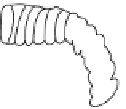Biomedical Engineering Reference
In-Depth Information
FIGURE 5.8
Red blood cell aggregates termed rou-
leaux, which can form linear or branched structures.
The number of red blood cells in a rouleaux can vary
from 2 to approximately 50. Red blood cells in the
microcirculation typically traverse through capillaries
within rouleaux structures.
you may recall from solid mechanics courses, viscoelastic solids have a definite yield
stress, which may account for the yield stress of blood.
5.5 PRE
SSURE, FLOW, AND RESISTANCE: ARTERIAL S
YSTEM
This and the following section will reiterate some of the important formulas that govern
the flow within the arterial system and the venous system (
Section 5.6
) from the previous
chapters. In the simplest case, the flow through a blood vessel (
Q
) is determined by the
pressure difference across the vessel (
P
) and the resistance to flow throughout the vessel
(
R
). This relationship follows an Ohm's Law form, where a driving force (
Δ
Δ
P
, in our case)
is proportional to the flow through the system (
Q
, in our case).
5
Δ
P
R
5
P
1
2
P
2
Q
ð
5
:
5
Þ
R
Under normal resting conditions, the blood flow rate is approximately 5 L/min. This
means that all of the blood within the body traverses the circulatory system once a minute.
Pressure difference is something that we have discussed numerous times before. Pressure
is easy to measure and is typically in units of mmHg. Resistance to flow, however, is some-
thing that cannot be measured; it can however be directly calculated from
Equation 5.5
.
Be cautioned that there are many properties that will affect
Q
and
R
, and
Equation 5.5
is
simplified to some extent.
Example
Calculate the resistance to blood flow within the descending aorta and the inferior vena cava.
Assume that the pressure difference between the distal portion of the aortic arch and the iliac
arteries is 20 mmHg. The pressure difference within the inferior vena cava is 3 mmHg. Assume
that the flow rate through both vessels is 4.5 L/min.






















Search WWH ::

Custom Search